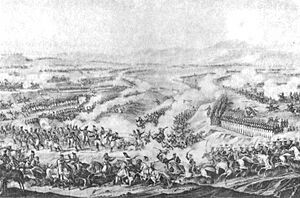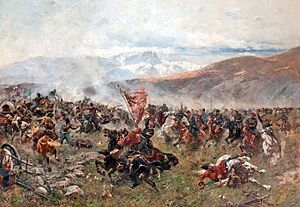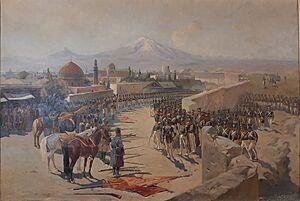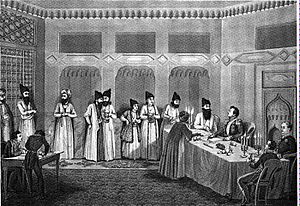Russo-Persian War (1826–1828) facts for kids
Quick facts for kids Russo-Persian War (1826–1828) |
|||||||||
|---|---|---|---|---|---|---|---|---|---|
| Part of the Russo-Persian Wars | |||||||||
 A picture from the time of the Battle of Ganja |
|||||||||
|
|||||||||
| Belligerents | |||||||||
| Commanders and leaders | |||||||||
The Russo-Persian War of 1826–1828 was the last big war between the Russian Empire and Qajar Iran. They fought over land in the South Caucasus region.
Russia wanted to expand its power, and Iran wanted to keep its lands. This led to major battles like the Battle of Ganja. At first, Iran did well, surprising the Russian army. Local people also helped Iran by rising up against Russian soldiers.
But then, Russia got more soldiers under General Ivan Paskevich. This changed the war. Russia started winning and captured the important city of Tabriz in Iran. The war ended with the Treaty of Turkmenchay in 1828. Iran lost its remaining lands in the Caucasus, including modern Armenia and parts of Azerbaijan and Turkey. The treaty also gave Russia some power in Iranian politics. After this war, Iran was never as strong as Russia or other European countries.
Contents
Why the War Started
Land Disputes in the Caucasus
Fath-Ali Shah Qajar (who ruled from 1797 to 1834) was the second king of Iran's new Qajar dynasty. He was immediately involved in a conflict with Russia over the Caucasus region. This area had been under Iranian control since 1502.
The Christian Kingdom of Kartli-Kakheti in Eastern Georgia had been ruled by Iran for many years. They decided to reject Iranian rule and asked Russia for help. This was a big deal for the Qajar dynasty. The previous king, Agha Mohammad Khan Qajar, had been killed in the Caucasus during a military campaign.
Russia's Growing Influence
Under the Russian tsar (emperor) Alexander I (who ruled from 1801 to 1825), Russia wanted to gain more power in the Caucasus. They had been interested in this region since the 1760s. Iran could not ignore Russia trying to take control of the Caucasus.
This led to the war of 1804–1813. It started when Russia invaded the Iranian city of Ganja and harmed its people. Iran lost this war and had to sign the Treaty of Gulistan.
The Treaty of Gulistan
The Treaty of Gulistan made Iran give up many areas to Russia. These included the sultanates of Shamshadil, Qazzaq, and Shuragol. Iran also lost the khanates of Baku, Derbent, Ganja, Shakki, Quba, Shirvan, Karabakh, and parts of Talish. Iran also had to give up its claims over Georgia.
The treaty was not very clear about the borders. For example, in Talish, it said that officials would decide the exact line. This meant that land arguments would continue after the treaty. One of the most argued areas was between Lake Gokcha and the city of Erivan.
Leading Up to the War

In early 1825, Russian forces took the northern part of Lake Gokcha. Iranians believed this area was part of their land. The Russian governor of Georgia, Aleksey Yermolov, ordered this. The Russian army then moved further and captured Balagh-lu. Iran knew these places could be used to attack Erivan.
Yermolov admitted that these lands belonged to Iran. But he said Iran was holding onto a large part of Karabakh. Russia also built a small fort near Erivan. Iran's crown prince, Abbas Mirza, protested this.
In mid-1825, the Iranian governor of the Erivan Khanate, Hossein Khan Sardar, attacked the fort. In 1826, news reached Iran that Russian Tsar Alexander I had died. The stories made it seem like there was a lot of confusion in Russia. In December 1825, a group of young officers tried to stop Alexander's brother, Nicholas, from becoming tsar. This was called the Decembrist Revolt. But troops loyal to Nicholas quickly stopped the rebellion.
On July 8, Russia captured Bash Aparan in northern Erivan. This was deep inside Iranian land. An Iranian-American historian, Maziar Behrooz, believes this was the start of the 1826–1828 war.
Debates in Iran
In Fath-Ali Shah's court, there were two groups of people. One group wanted peace with Russia, and the other wanted war. Both groups tried to convince Fath-Ali Shah and Abbas Mirza. The main question was what to do if Russia did not leave Gokcha and Balagh-lu. They also thought about how Muslims were treated under Russian rule. And they wondered if Russia was weaker after its internal problems.
The group who wanted peace included the foreign minister Mirza Abolhassan Khan Ilchi. They were afraid of Russia's power and wanted to avoid war. They knew more about other cultures and Russia.
The group who wanted war included religious scholars like Agha Sayyed Mohammad Esfahani. They also included Fath-Ali Shah's chief minister Asef al-Dowleh. They believed Russia had insulted Iran and acted aggressively. Agha Sayyed Mohammad told Fath-Ali Shah that he had a duty as king and as a Muslim leader. He spoke about Russia taking Iranian land and how Muslims were treated. This group also thought Russia was weak, especially in the Caucasus, because of recent defeats and the Decembrist revolt.
The Council of Soltaniyeh met to decide what to do. In the end, the group wanting war won. The final decision was to start a full-scale war against Russia.
The War Begins

Iran started the war well in the summer of 1826, even though Abbas Mirza's soldiers seemed unprepared. This happened for two reasons. First, the Russian commander Yermolov was busy fighting in Chechnya. His soldiers were not ready for a new war. Second, the Muslim people in the area rose up against the Russians. They were tired of being treated badly.
In Shirvan, Ganja, Talish, Shakki, and Karabakh, Russian troops were either forced out or left. It is not clear if rebellions happened in Quba, Baku, Derbent, and Georgia.
Early Iranian Successes
On July 25 and 26, Russian and Iranian forces began fighting in Talish. From July 28 to 30, the Russian army fought a tough battle against Sardar. He captured Pambak and Shuregol in northern Erivan. Meanwhile, his brother Hasan Khan Sari Aslan attacked further north, making the Russians retreat to Tiflis.
From August 1 to 3, Sardar took back Bash Aparan. He then started fighting the Russians at Gyumri. On August 12, Iranian forces captured Lankaran and Saliyan. During this time, Abbas Mirza's army of 35,000 soldiers defeated a Russian group of 800 soldiers. Iran sent 400 heads to Fath-Ali Shah's camp and 400 prisoners of war to Tabriz. This included the Russian commander and 17 officers.
Turning Point at Ganja
While some of his troops fought in Talish, Abbas Mirza began to surround Shusha on August 6. But things started to go wrong for Iran. Abbas Mirza did not attack Shusha's fortress directly. He knew it would take a long time. Instead, he sent his oldest son, Mohammad Mirza, with his uncle Amir Khan Devellu-Qajar to take control of Ganja.
The Russian commander of Shusha, Colonel Iosif Reutt, disarmed the Muslims there. He then defended the city well with the help of local Armenians. The siege of Shusha lasted a long time because Abbas Mirza's cannons could not break through. Iosif started talking with Abbas Mirza to gain time while waiting for Russian help.
Amir Khan asked Abbas Mirza for more cannons and soldiers to fight the Russian army coming to help. This army was led by Lieutenant General Valerian Madatov. Abbas Mirza told Amir Khan to wait inside Ganja castle. But Amir Khan learned that Madatov's army was large (10,000 Cossacks, twelve groups of foot soldiers, and twelve cannons). He gathered 5,000 horsemen and, with Mohammad Mirza, marched towards Shamkor.
This led to the Battle of Shamkor on September 16. Madatov defeated Amir Khan's forces, and Amir Khan was killed. Mohammad Mirza went back to Ganja. The defenders of Ganja soon left the city and went to Shusha.
On September 17, Ganja surrendered to Madatov without a fight. General Ivan Paskevich arrived in the Caucasus on September 22 with more soldiers. He took command of the Russian forces on September 29, replacing Yermolov. Paskevich was a skilled commander who had fought well in the Napoleonic Wars and against the Ottoman Empire.
On the same day, Abbas Mirza marched towards Ganja, leaving a small group to continue the siege of Shusha. From October 13-17, the Battle of Ganja took place near the tomb of the famous Persian poet Nizami Ganjavi. Abbas Mirza had three of his sons with different parts of his 30,000-man army. Mohammad Mirza led one group. His two younger sons, Jahangir Mirza and Khosrow Mirza, were with other groups.
But Abbas Mirza worried about his younger sons' safety during the battle. He ordered their teachers to take them away. This move caused the center of his army to break apart, leading to his defeat. This was the most important battle of the war. After this, Iran's defeat was almost certain. Someone who saw the Battle of Ganja said, "The action was at first well contested; and had Abbas Mirza possessed the talent of a commander, the Russian power in Georgia would have been at an end."
Final Russian Victories
By 1827, Abbas Mirza was losing the war. He had to stop attacking and start defending. In January, Madatov led a fourteen-day raid south of the River Aras. In April, Etchmiadzin surrendered. In July, two fortresses in Nakhichevan, Abbasabad and Ordubad, were surrounded.
On July 7, Paskevich defeated Abbas Mirza, who had come to help the fortresses. Both fortresses then gave up. In September, the strong fortress of Erivan surrendered after being surrounded and heavily bombed. The fortress of Sardarabad also fell. Paskevich used powerful cannons to destroy Erivan's walls. Sardar escaped Erivan before it was taken. But other commanders, including Hasan Khan Sari Aslan, Hamzeh Khan Anzali, and Mahmud Khan Maqsudilu, were captured and sent to Tiflis.
On October 24, 1827, Tabriz, Iran's richest and most populated city, surrendered without a fight. This happened even though Asef al-Dowleh had an army of 20,000 men. An Islamic scholar gave the city to Paskevich. Later, Fath-Ali Shah ordered Asef al-Dowleh to be punished for giving up the city. He was publicly whipped while Abbas Mirza and Fath-Ali Shah watched. On January 25, 1828, the Russians captured and looted Ardabil. They took valuable jewelry from the Safavid era.
After the War
On February 2, 1828, Abbas Mirza signed the Treaty of Turkmenchay. This treaty made Iran give up Erivan and Nakhichevan to Russia. Iran also had to pay a lot of money for the war and agree to other things. Most of this money came from the province of Azerbaijan and Abbas Mirza's own wealth. A small part came from the British.
The treaty also gave Russia a way to get involved in Iranian politics. The Iranian king now needed Russia's approval for who he wanted to name as his heir. Iran might have lost even more land or become a Russian puppet state. But this was avoided either because Iranian negotiators were very determined (with British help) or because Russia wanted to make peace quickly. Russia was likely preparing for another war with the Ottomans. After this war, the Qajar state in Iran was never again seen as equal to Russia or other European countries.
The Iranian defeat changed how Abol-Qasem Qa'em-Maqam, a close advisor to Abbas Mirza, felt about the Russians. In one of his poems, he showed sadness about Iran's changed fortune. He now knew that Russia, not Iran, was the stronger power.
The Griboyedov Incident
In 1829, a famous Russian poet, Alexander Griboyedov, led a large Russian group to the capital city of Tehran. His job was to make sure the Treaty of Turkmenchay was followed. He ordered that Georgian women who were held in the homes of Iranian nobles (like Asef al-Dowleh) be set free and given to him. He did this because an Armenian eunuch, who had been captured in earlier wars, asked him to. Griboyedov sent his Armenian and Georgian helpers to bring the women to the Russian embassy. He used a part of the treaty that said prisoners of war should be exchanged.
This act was seen as a big insult to Iranian law and Shia religious customs. Asef al-Dowleh asked for help from a local Islamic scholar, Mirza Masih Tehrani. This scholar told the people of Tehran to rise up. He asked them to rescue the women, who had likely become Muslim, and bring them back to their Muslim homes. Three protesters died in fights with Russian guards.
Then, Mirza Masih Tehrani issued a religious order (a fatwa). This led to an angry crowd attacking the Russian embassy. Griboyedov and all but one of the seventy people in the embassy were killed.
Historian Maziar Behrooz says that "the nervous Iranian reaction was telling and shows how much attitudes toward Russia had changed in Iran." An Iranian historian from that time said that when Crown Prince Abbas Mirza heard what happened, he ordered all soldiers and nobles to wear black clothes for mourning. All the markets were closed for three days, and everyone stopped working. To apologize, Fath-Ali Shah sent a diplomatic team to Nicholas I. Khosrow Mirza led this important team to Saint Petersburg in 1829.




